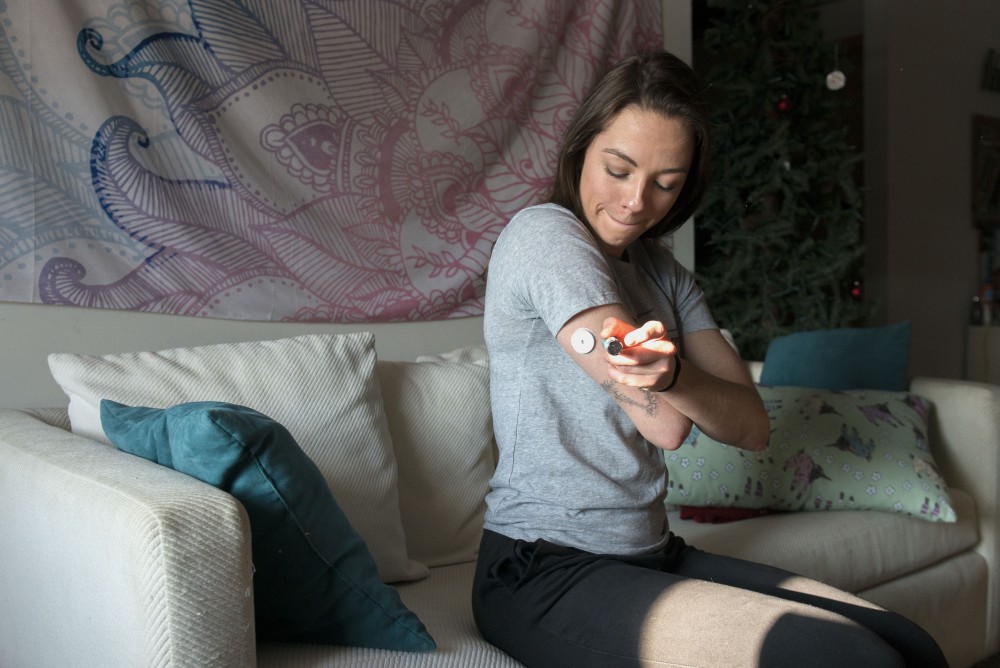The day after her 10th birthday, University of Minnesota senior Kaila Kemnetz-Ness was diagnosed with Type 1 diabetes. It’s the worst birthday present she’s ever received, she said.
Since then, shots and blood tests have become a mundane and daily occurrence in Kemnetz-Ness’ life. She now has a continuous glucose monitor and wireless insulin pump, which she says has improved her diabetes management, but she still struggles to manage the disease.
She’s not alone.
Kemnetz-Ness, who works as a pharmacy technician at Walgreens, said she’s had to turn away diabetics who couldn’t afford to pay for their insulin.
That’s why she wasn’t surprised when the Minnesota Department of Health released a paper in late November showing the number of hospitalizations was higher in young diabetics — those age 18-44 — than their older counterparts.
“[College] is a critical moment in life when you have all these other priorities, so it’s easy to put diabetes on the back burner. You don’t see immediate consequences, usually, but obviously not taking care of yourself can lead to complications,” Kemnetz-Ness said.
Diabetes is an autoimmune disorder in which the pancreas no longer secretes insulin. Complications include damage to kidneys, nerves and eyes, as well as pregnancy problems. The paper may point to some underlying issues in how diabetes is addressed and cared for.
“There are little bread crumbs in the study that make you think about what’s really going on underneath,” said Renee Kidney, an author of the paper and an epidemiologist with the Minnesota Department of Health.
The paper also states that young diabetics were more likely to be hospitalized due to mental health conditions.

Anna Ribbens, a student in the school of nursing and the president of the College Diabetes Network at Minnesota, said she was not shocked by this claim.
“It’s always weird to be someone with Type 1 diabetes, it often feels like you’re alone,” she said.
Ribbens said that physical and mental health are related. Most diabetics, at some point, feel something known as “diabetes burnout” — being overwhelmed and disheartened by the constant regulation and self-monitoring demanded by the chronic disease.
Diabulimia, a means of calorie-purging by taking less insulin, is something not talked about enough in the diabetic community, Ribbens said.
“Diabetes and food — there’s such a relationship there, so it’s easy to just take that extra step and turn it into an eating disorder,” she said.

Diabetes and eating disorders: a constant numbers game
Ann Goebel-Fabbri, a licensed psychologist and assistant professor of psychiatry at Harvard Medical School, said that eating disorders within the diabetic community need to be looked at more closely.
“The research shows that upwards of 35 percent of women will restrict insulin for weight loss at some point,” she said.
Females with diabetes are almost 2.5 times more likely to develop an eating disorder than those without, Goebel-Fabbri said. However, eating disorders within the Type 1 community are still a relatively underserved niche audience.
There are few eating disorder clinics in the country that focus on diabetes. One of which — called the Melrose Institute — is located in St. Louis Park.
Andrea Zuellig works at the Melrose Institute, which partners with the International Diabetes Center.
“People with eating disorders have a big drive for perfection,” Zuellig said. “Combine that with diabetes, and it’s a nightmare. People get super focused on having perfect blood sugars or A1C numbers, and that gets very difficult when people are trying to maintain their weight in a certain range, too.”
The price of a chronic illness
According to the American Diabetes Association, the cost of insulin nearly tripled between 2002 and 2013.
Because of regulations and its difficult-to-copy biology, there are no generic versions of insulin, meaning it can be extremely difficult to access.
This may be why, according to one study conducted by Yale University, nearly 1 in 4 diabetics have rationed insulin before, citing its high cost. This may also account the 2017 case of Minnesotan Alec Smith, a 26-year-old who died less than one month after being aged off of his mother’s insurance.
“His employer didn’t offer insurance. He decided he would just look for a new job that offered benefits,” said Nicole Smith-Holt, Alec Smith’s mother. “His insulin and supplies were about $1,300 a month without insurance. Though he’d be on a tight budget, he thought he could afford it.”
Alec Smith was found in his apartment, the cause of death being diabetic ketoacidosis, three days before his payday.
Many young diabetics say it’s impossible not to see a reflection of themselves in Alec’s story.
“When the choice comes between paying your rent for the month and purchasing insulin, you have to say what’s more immediately important. And, to some people, having a roof overhead is more immediately important,” Ribbens said.
A daily struggle
While being diagnosed with diabetes is no longer necessarily the death sentence it was years ago, it’s still a life sentence.
A diver at the University, senior Morgan Justus, said her endocrinologist once recommended that she discontinue diving, one of her favorite activities, because of the impact it has on her glucose levels.

A recent University graduate, Trevor Omann, said that his mom would keep his blood sugar levels elevated because she feared his blood sugar becoming too low — a habit that was difficult for him to kick once he was in college, managing his diabetes on his own for the first time.
Kemnetz-Ness said that she worries what will happen when she’s kicked off of her parents’ insurance if she enrolls in graduate school like she plans.
Goebel-Fabbri said she’s worked with diabetics who have had to choose between a career they enjoy and one that will ensure they’ll be able to afford the medications and supplies they need to live.
“Type 1 is an incredible burden that’s 24 hours a day. No matter what a person is doing, they’re thinking about that and their blood glucose in the background,” she said.
Goebel-Fabbri said that she feels encouraged that some organizations are becoming better mental health advocates.
“I think that some organizations are coming to realize that we have to aim at two different targets — the medical aspects, like a cure,” she said. “But while we’re waiting for that, we have to help people have a better quality of life.”

Clarification: A previous version of this article misstated Anna Ribbens’ job title. Ribbens is the president of College Diabetes Network at Minnesota.













